It's National Pathology Week 2010 and to celebrate the launch we're joined by pathologist Dr Suzy Lishman to take on your science questions! We'll find out where phlegm comes from, how petroleum jelly helps healing and the weight of red blood cells synthesised in a human lifetime. Also, can you concentrate lasers with lenses, why does an open carport stop frost, and if carnivorous plants photosynthesise, why do they need to eat insects? Plus, how researchers in Scotland are sniffing out pollution with such sensitivity, they can detect forest fires all the way from Canada! In Kitchen Science, Dave reads his credit card using rust!
In this episode
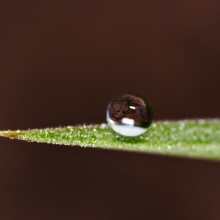
01:54 - Super-Waterproof Cotton
Super-Waterproof Cotton
Waterproof clothing has got a lot more comfortable over the last 20 years with the invention of various breathable fabrics. One common strategy is to make the fabric super hydrophpbic or very very water repellant, this means that despite the fact that it is covered with holes so water vapour from sweat can escape, water 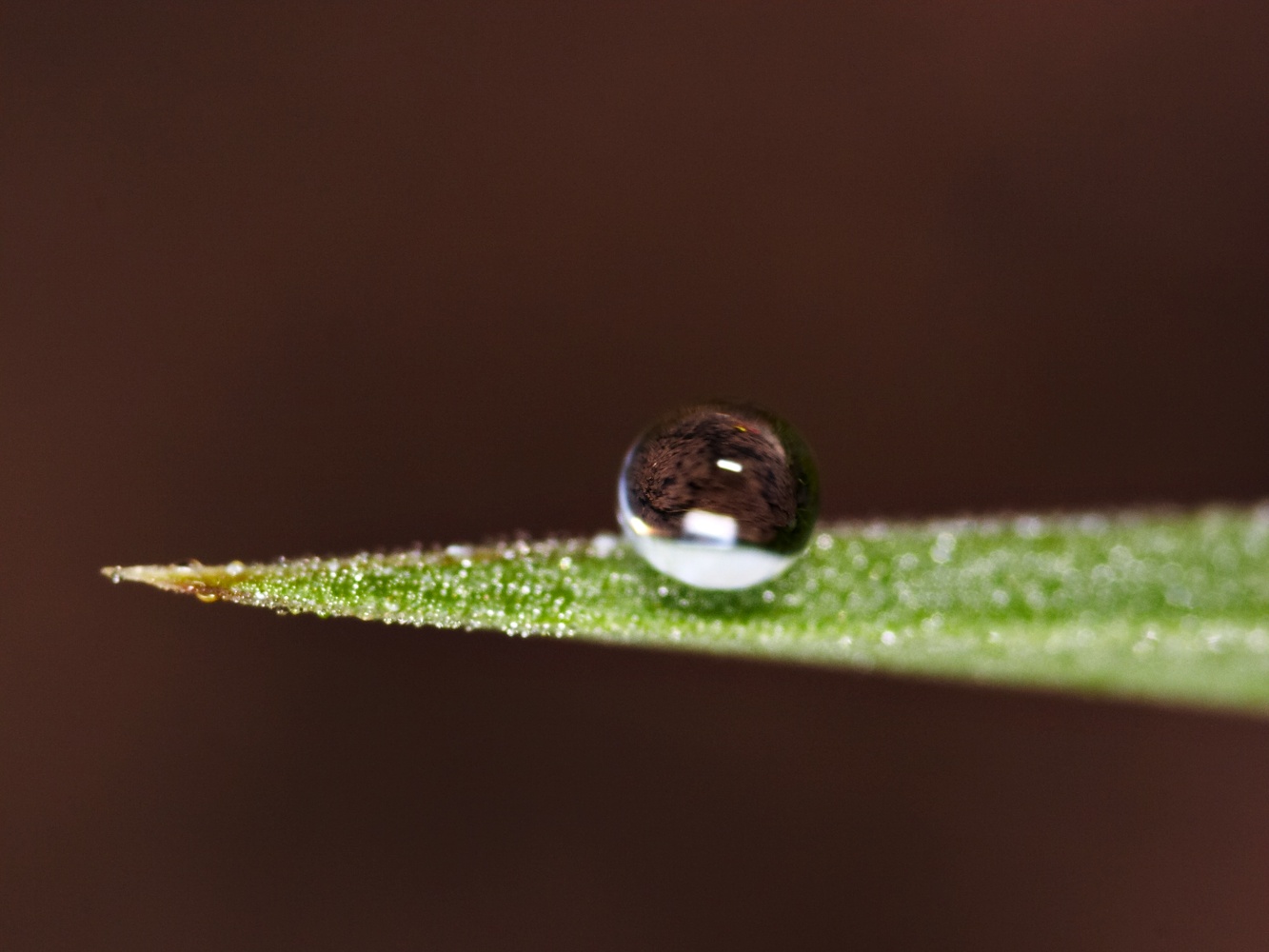 droplets can't get through because they are bigger than the holes. The bigger the holes the more breathable the fabric is, but to stay waterproof, you also need to make the fabric more hydrophobic. While there are superhydrophobic coatings which could make a sieve reasonably waterproof, the problem is that most of the hydrophobic coatings are not especially robust, and whilst your coat might be very water repelant when it is new, if you wash it, you also wash off the water repellancy.
droplets can't get through because they are bigger than the holes. The bigger the holes the more breathable the fabric is, but to stay waterproof, you also need to make the fabric more hydrophobic. While there are superhydrophobic coatings which could make a sieve reasonably waterproof, the problem is that most of the hydrophobic coatings are not especially robust, and whilst your coat might be very water repelant when it is new, if you wash it, you also wash off the water repellancy.
Bo Deng and collegues at the Shanghai institute of applied physics have been working on this, they took a commercially available super-hydrophobic coating, a heavily fluorinated acrylate polymer. Instead of adding some kind of catalyst to cause the acrylate monomer to form a polymer they irradiated cotton soaked in a solution of the monomer with gamma rays. Sometimes a gamma ray will hit the cotton, break some bonds in the cotton and allow the polymer to to start forming at this pont. This means that the polymer molecules are strongly bonded to the cotton.
The fabrics they produce will allow a droplet of water to roll around the surface without wetting it at all, and more impressively will keep this property after the equivalent of 250 washes.
As well as making great coats, they suggest that the cotton might be useful in floatation devices as if you made the filling of a lifejacket, or even a fisherman's coat or shirt, out of this superhydrophobic cotton, it would repel water, and so be covered with a layer of air and so produce significant floatation if you fell in the water.
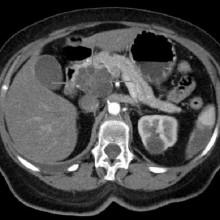
05:35 - Pancreatic cancer takes ten years to spread
Pancreatic cancer takes ten years to spread
Scientists studying tumour samples pancreatic cancer victims have made a surprising discovery - the disease appears to take a very long time to develop before it begins to spread.
The prognosis for pancreatic malignancies is almost universally dire with a 5 year survival rate of about 5-10%. This is because the disease tends to reveal itself very late, by which time the tumour has often already spread - metastasised - to other tissues.
 But this grim outcome could be improved thanks to a new study published in the journal Nature and carried out by Johns Hopkins-based scientist Christine Iacobuzio-Donahue and her colleagues. This team obtained fresh autopsy tissue from 7 patients who had died from pancreatic cancer.
But this grim outcome could be improved thanks to a new study published in the journal Nature and carried out by Johns Hopkins-based scientist Christine Iacobuzio-Donahue and her colleagues. This team obtained fresh autopsy tissue from 7 patients who had died from pancreatic cancer.
By extracting viable cells and DNA from the tumour deposits in these patients, including from both the primary pancreatic tumour and the metastases, the researchers were able to build an evolutionary tree tracing the acquisition of the DNA mutations that triggered the tumours and then the disease spread. The bulk of the DNA damage linked to the disease, they found, was already present in the primary tumour, and they could trace "sub-clones" of the primary that had given rise to different metastatic events around the body.
This result shows that, contrary to prevailing wisdom - that potentially cancerous cells spread early and then turn into tumours later - does not apply to pancreatic cancer. Moreover, using mathematical algorithms to track the rate of disease progression, the team were able to determine that it takes on average 11.7 years before the first cancer cell develops within a high grade lesion, then a further 7 years before the cancer the potential to spread and, finally, about 2 and a half years from then until a patient's death. This suggests that early detection and early intervention could dramatically improve what is currently an appalling prognosis.

09:17 - One in Five Sun-like stars have Earth-like Planets
One in Five Sun-like stars have Earth-like Planets
with Dr Andrew Howard, University of California, Berkely
Chris - Also this week, we have heard good news that we may not be alone or at least, not so lonely in the universe as we maybe first thought because researchers in America have announced that as many as 23% of stars like our Sun could have Earth-sized planets orbiting around them. To explain how they came to this figure and what it means for the search for other worlds a bit like our own, we're joined now by Dr. Andrew Howard who is at the University of California at Berkeley. Hello, Andrew.
Andrew - Hello.
Chris - Andrew, tell us first of all, how did you actually do this study?
 Andrew - So we used the Keck telescope in Hawaii and essentially what we did was conduct a census of the planets orbiting the stars nearest to our own solar system. We looked at each one of the 166 stars night after night for almost 5 years. We didn't look at them every single night but we were able to detect the most massive planets - those planets that are even bigger than Jupiter- as well as less-massive planets - those planets that were down to a mass of about 3 times the mass of the Earth. So we covered this enormous mass range from 3 Earth masses, all the way up to a thousand Earth masses. We can't quite detect the Earths, which we'd really like to, but we can extrapolate their numbers based on a really clear trend that we see from having relatively few planets. At the high mass end, we see only about 1 or 2 Jupiters per 100 stars in our survey. Down at the low mass end, we see a lot more planets in the 3 to 10 Earth mass range. We see something like 12 planets per 100 stars. And so, if you just extrapolate this trend that we see over a very large mass rates down to one Earth mass planets, we estimate that about 23% of stars like the sun have a relatively close-in planet like the Earth.
Andrew - So we used the Keck telescope in Hawaii and essentially what we did was conduct a census of the planets orbiting the stars nearest to our own solar system. We looked at each one of the 166 stars night after night for almost 5 years. We didn't look at them every single night but we were able to detect the most massive planets - those planets that are even bigger than Jupiter- as well as less-massive planets - those planets that were down to a mass of about 3 times the mass of the Earth. So we covered this enormous mass range from 3 Earth masses, all the way up to a thousand Earth masses. We can't quite detect the Earths, which we'd really like to, but we can extrapolate their numbers based on a really clear trend that we see from having relatively few planets. At the high mass end, we see only about 1 or 2 Jupiters per 100 stars in our survey. Down at the low mass end, we see a lot more planets in the 3 to 10 Earth mass range. We see something like 12 planets per 100 stars. And so, if you just extrapolate this trend that we see over a very large mass rates down to one Earth mass planets, we estimate that about 23% of stars like the sun have a relatively close-in planet like the Earth.
Chris - That's a big number, isn't it?
Andrew - Twenty three is a really big number. This number has sometimes been called Eta of Earth for the Greek character Eta. This is a term that's appeared in Frank Drake's equation that's used to estimate the prospects for SETI. And Eta of Earth had remained kind of a mystery. People always wanted to know, are Earth-like planets common or are they rare and some people estimated that it was 100%. Some people estimated that it was one in a million. We say 23% or about 1 in 4 and to be fair, we had a little bit of an extrapolation here, and I wouldn't be surprised if the true number is 1 in 2 or maybe in 1 in 8, but it's not 1 in 100, and that's a really big improvement in our knowledge.
Chris - If we could visit some of these distant worlds, what would they be like? What are the prospects that they're in the same position, relative to their star, that our Earth is and therefore, have the kinds of conditions that this planet does - in other words, it's not too hot, not too cold, we've got liquid water?
Andrew - The technique we used is the Doppler method, sometimes called the Wobble method, and it turns out that we're most sensitive to planets that are really close to their host stars. So we were only able to detect planets out to a quarter of the Earth-sun distance. So at that really close orbital distance which is, if you put the planets inside the solar system, they'd be inside the orbit of Mercury. These are really hot planets. I really seriously doubt that there's life on these specific planets, but what they tell us is that nature makes small planets commonly and deposits them at close orbital distances, and it seems reasonable to suppose that if there are planets at close orbital distances, there are probably planets a little farther out where the radiation from the Sun isn't so intense and these planets might be in the so-called Goldilocks zone or the habitable zone of planets where the temperature is not too hot, not to cold. It's just right for liquid water and perhaps, for life to evolve.
Chris - How does this finding sit with our understanding of how systems like our own do put themselves together and evolve in the first place?
 Andrew - It's really interesting that these so-called theories of planet formation, there's this dominant paradigm which is called the core accretion model. This is a model that's been long-standing, and it predicts that most planets in all solar systems are born in the cool outer reaches far from the host star. And the main reason is because, to efficiently make the core of a planet, you need ice and to have ice, you have to be in a cooler part of the solar system, that it's far from the host star. So this model predicts that most planets are born out there. Some of them grow up to be quite large, the size of Saturns and Jupiters, and some do not. Some are a whole range of sizes - from smaller than the Earth to Earth-size to a little bit bigger, but the theory also predicts that it's basically only the largest planets, the gas giants like Saturn and Jupiter that migrate close to their host star. So this theory made a prediction for our observations and they predicted that we would only detect large close-in planets, and we shouldn't detect very many small close-in planets. And they actually had a name for this. The theorists called this The Planet Desert. They predicted there'd be almost no close-in small planets.
Andrew - It's really interesting that these so-called theories of planet formation, there's this dominant paradigm which is called the core accretion model. This is a model that's been long-standing, and it predicts that most planets in all solar systems are born in the cool outer reaches far from the host star. And the main reason is because, to efficiently make the core of a planet, you need ice and to have ice, you have to be in a cooler part of the solar system, that it's far from the host star. So this model predicts that most planets are born out there. Some of them grow up to be quite large, the size of Saturns and Jupiters, and some do not. Some are a whole range of sizes - from smaller than the Earth to Earth-size to a little bit bigger, but the theory also predicts that it's basically only the largest planets, the gas giants like Saturn and Jupiter that migrate close to their host star. So this theory made a prediction for our observations and they predicted that we would only detect large close-in planets, and we shouldn't detect very many small close-in planets. And they actually had a name for this. The theorists called this The Planet Desert. They predicted there'd be almost no close-in small planets.
Chris - But instead you've detected an oasis there, haven't you? You've got a whole lot of them. One in four of them have got small planets.
Andrew - It's a tropical rainforest. It's the opposite of a desert. So, I think the whole theory of planet formation by core accretion, I don't think it needs to be thrown out, but I think that in particular, this migration part of it is not right and it needs to be revised.

14:55 - New form of transistor developed
New form of transistor developed
Almost all analog electronics, from cassette players to the radio parts of mobile phones, are based around transistor amplifiers. These are circuits based on transistors which will take an input signal and amplify the voltage or the current to produce a much larger output.
 There are 2 main types of amplifier: Positive gain, where if you increase the input you increase the output; and negative gain, where if you increase the input the output decreases. These both involve different physical types of transistor, so if you want an amplifier to do both the circuit you need gets much more complex.
There are 2 main types of amplifier: Positive gain, where if you increase the input you increase the output; and negative gain, where if you increase the input the output decreases. These both involve different physical types of transistor, so if you want an amplifier to do both the circuit you need gets much more complex.
Xuebei Yang and colleagues from Rice University in Houston has been working on transistors made form graphene, the promising material that consists of a single layer of carbon. The transistors they have built change their behaviour entirely depending on the bias voltage you apply to them, changing from positive gain to negative gain, through an intermediate frequency doubling state.
This could make simple amplifiers slightly more flexible but they say that it could have a much bigger effect on transmitters that encode the signal in the frequency or the phase of the signal, plus whatever the very innovative electronic engineers can come up with. Ultimately, this technology could lead to smaller, cheaper and possibly more power efficient mobile phones and other radio devices. Also, as graphene has very good high frequency properties, they could work a lot faster than the present ones!

17:01 - Thinking along the right lines
Thinking along the right lines
In a study that informs our understanding of how the brain allocates attention to different stimuli, scientists have successfully enabled human volunteers to choose between images on a computer screen just by altering their thoughts...
Writing in Nature, Caltech-based researcher Moran Cerf and his colleagues describe how they recruited 12 epileptic patients who were undergoing brain studies to identify the sources of their seizures.
Arrays of 64 electrodes had been temporarily implanted into the medial temporal lobes of the patients to monitor brain activity. The researchers showed the subjects over 100 images of familiar people, places, animals and buildings including Marilyn Monroe and Bill Clinton. Four electrodes that registered nerve cell activity exclusively when a subject viewed a specific image were then identified.
Next, in a thirty minute trial, the subjects were shown combinations of the four images with two of them superimposed in a semi-transparent manner on a screen, one in front of the other. A computer was programmed to monitor the output from the electrodes and to increase the visibility (opacity) of an image when the electrode to which it was linked detected more brain activity.
In each trial, the subjects were then instructed to try to make one of the two images more visible and fade out the other, by whatever thought processes they wished.Incredibly, in 69% of cases, and with no prior training, the subjects were able to manipulate the computer image, with half of them reporting that they just "concentrated on the face they were interested in".
Intruigingly, the setup also allowed the team to probe the process of attention. They had expected that, when a subject was instructed to focus on, say, Marilyn Monroe, the electrode corresponding to her picture would become more active. Instead, the non-Marilyn Monroe electrodes became less active. In this way the brain is clearly focusing attention by reducing the level of distraction, almost like focusing the beam of a spotlamp on one part of a drama unfolding on stage.
And apart from academic interest, the new technique may be useful from a practical perspective since it might be possible to design a system to help paralysed patients to regain control over their environment. "We could actually learn how their brain looks when they think of water, food, or pain," says Cerf. This would allow a patient to communicate with doctors again.

Why would an open carport stop frost?
Dave Ansell answered this icy question...
Dave - To understand this, you've got to understand first of all, what is frost and how is it happening?
Basically, what happens is, at night - especially if there's a clear sky at night - anything which is warm radiates heat. You're radiating heat all the time, that's the thing which the heat cameras you sometimes see on these films on the TV are seeing when people glow really brightly. That's because they're warmer. They're radiating more infrared heat. So, basically, the warmer something is, the more heat it loses. If you're inside the house, you're losing heat all the time, but so are the walls. You're heated up by the heat coming off the walls and it's heated by you, so you don't feel that cold, because actually quite a lot of energy is beamed into you from the walls of the house.
But, if you go outside on a cold clear night, you're basically just seeing the sky, and the temperature of deep space is about 2.9 degrees above absolute zero - about minus 270 degrees centigrade. That's really, really cold. So there's no heat coming down onto you and so you're just radiating heat and you lose heat very quickly. The same thing happens to the ground. The ground loses heat very quickly. It cools down and then once it gets below the frost point of the air, water starts condensing out of the air onto it and starts forming frost. Eventually all the water is condensed out of the air and it becomes very dry. There's nothing more left to condense out.
Whereas, under a carport, the top of the roof will cool down quite a lot, probably down to slightly below zero, but that's still a lot, lot warmer than the sky. So the roof is still radiating some heat down onto the ground, inside the carport, so that keeps it slightly warmer than everything else. Because of this, all of the moisture tends to condense everywhere else rather than inside the carport. So, even if, by the end of the night, it did get down to below zero, all the water vapour is already condensed everywhere else. So, there's no frost inside the carport.
Chris - And I will add that, perhaps the water which is going to condense is going to come down out of the sky and if there is a physical barrier there, then it's likely to settle on that roof, more than on the car underneath the roof, and therefore, there isn't anything to freeze on the glass even though the glass is very, very cold anyway. You're going to end up with a clear windscreen rather than a frosty one...

Why are planets spherical but meteorites irregularly shaped?
If you look at things from a long way away like the Sun, like the Earth, like Mars - yes, they do look like big circles in the sky, that's true. If you zoomed in a bit closely, you'd see that actually, the surfaces are quite lumpy and bumpy. The Earth has mountains and volcanoes, and so does Mars.
So the surface isn't completely smooth, but yes, they have been pulled into a circular shape. Whereas, smaller objects like things in the asteroid belt can be an irregular shape.
What's different between the things in the asteroid belt and big planets like the Earth and even big blobs of gas like the Sun is that the Earth, Mars and the Sun are very big, therefore they have enormous amounts of mass, and therefore, they have an enormous amount of gravity. And what that gravity is doing is pulling all of the particles together, and the way in which the particles can arrange themselves so they are as close as they can be to each other is into a spherical shape. It gives you the best surface area to volume ratio. So in other words, everything is surrounded by everything else and pulling towards everything else as tightly as it can.
A smaller object like an asteroid doesn't have the same mass. It's much smaller and they're much therefore more loosely bound together and there isn't the gravity to pull the material together into a spherical shape. If you kept adding material then it would accrete slowly to make a planet.
In fact, the asteroid belt is a failed planet. It's rubble left over from planet building, probably because there wasn't sufficient gravity there to pull a planet together and hold it together, up against the gravitational tugs of all of the other planets forming in the solar system. So that's really the reason.

26:06 - National Pathology Week
National Pathology Week
with Dr Suzy Lishman, Royal College of Pathologists
Chris - Thank you for coming in to talk to us on the Naked Scientists. It is National Pathology Week, so tell us what that's all about.
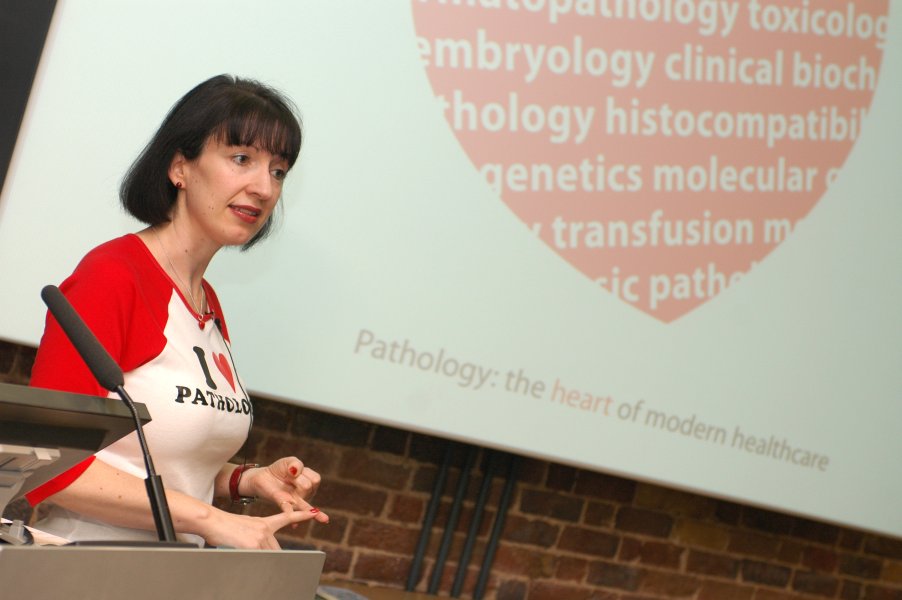 Suzy - Well this is the 3rd time that the Royal College of Pathologists has organised this week and the idea is that we highlight the role that pathologists and scientists play in keeping people healthy. When people think of pathology, they often think of things like CSI and Silent Witness, and dead bodies, but actually, dealing with dead people is a very tiny part of what pathologists do, and the vast majority of their time is spent helping the living. So this week, there'll be over 500 events taking place all around the country so people can go along to laboratory open days and have a look behind the scenes. There'll be school visits, art competitions, interactive workshops, quizzes - a whole range of things happening to highlight what pathology is all about.
Suzy - Well this is the 3rd time that the Royal College of Pathologists has organised this week and the idea is that we highlight the role that pathologists and scientists play in keeping people healthy. When people think of pathology, they often think of things like CSI and Silent Witness, and dead bodies, but actually, dealing with dead people is a very tiny part of what pathologists do, and the vast majority of their time is spent helping the living. So this week, there'll be over 500 events taking place all around the country so people can go along to laboratory open days and have a look behind the scenes. There'll be school visits, art competitions, interactive workshops, quizzes - a whole range of things happening to highlight what pathology is all about.
Chris - It's all free and the idea here is to try to tell people really what this hidden art is all about. As you say, many people think pathology is all about dead bodies, but it's far more than that.
You can find
podcasts of previous National Pathology Week events here.
More information on this year's National Pathology Week is available at nationalpathologyweek.org.
Suzy stayed with us for the show to answer your questions,
find them here!
How do I get into Pathology?
We put this to Dr Suzy Lishman: Suzy - To be a pathologist, you need to do a medical degree first. So, after getting good GCSEs and A levels, hopefully get into medical school which is getting harder to do year by year. Then you'll spend 3 or 6 years as a medical student, followed by 2 years of foundation training that all doctors do before they start to specialise. Then you can apply to a specialist training program which is a minimum of 5 years. So we're looking at probably 12 years or so from deciding to go medical school, to actually getting to the end of your pathology training. Many people actually take time out along that time to do some extra research, perhaps a PhD or specialise in something. So it can take even longer.
Chris - When I tell people I'm still taking exams at the age of 35 - I think I finally finished them, I think I've taken my last exam now - they're normally quite gobsmacked!

How do wounds heal when petroleum jelly is applied?
We put this question to Dr Suzy Lishman:
Suzy - Thanks, Daniel. It's a good question. I think the first thing to say is the petroleum jelly itself has no medicinal effect and it doesn't actually effect whether a blister forms, and it's not absorbed. So, it doesn't get absorbed into the wound. But its effectiveness in wound healing is related to its sealing effect on cuts and burns. So what it does, it stops germs getting into the wound so it doesn't get infected so it can heal more quickly. It also keeps the area supple. It prevents the skin's moisture from evaporating, so it stays nice and moist, and supple, and it enables that area to heal without cracking.
The really important thing about putting petroleum jelly on burns for example is, you must not put it on a fresh burn because burns continue to damage the surrounding skin for some time because the heat continues after the initial burn occurs. If you put Vaseline over the top of that, then it will actually trap the heat in and more damage will be done to the underlying skin. So it's essential that you wait until the burn is completely cooled down before sealing it.
Chris - The other interesting about the way wounds heal, that has been discovered fairly recently, is they actually create an electrical current into the wound. Researchers in Aberdeen started measuring this, they put a wire in the root of the wound and the wire on the edge of the wound, and they could measure an electrical voltage difference between the two, and the cells flowed down the potential difference. So they can sense the voltage and they move into the base of the wound from the margin of the wound where it's healing up. And because they're blebbing off from the side, if you do put a layer of petroleum jelly over the top, they're just going to go underneath it. Aren't they, Suzy?
Suzy - Yes, they are. They're not bothered whether it's there. It just gets in the way. They go around the edge of it. So, it doesn't actually have much effect on the wound healing itself. It just enables it to happen.
Can lasers be concentrated with lenses?
Dave - Well, the simple answer is yes. It's done all the time. Virtually any laser which you've seen cutting anything would've been focused with a lens. In fact, the beautiful thing about laser light is it's far more focusable that ordinary light. It essentially behaves as if it was coming from a very, very small point source so you can focus it very, very, very tight and it works beautifully. Focusing multiple lasers into the same beam is much more difficult. You can focus lots and lots of different lasers in to the same place so you can get lots of crossing focused laser beams onto a single point which is what certainly the American government is trying to do for nuclear fusion things. They put little tiny pellets of frozen hydrogen, deuterium, into the focus of these hugely powerful lasers. That then compresses it so much that it can actually get so hot - far hotter than the centre of the Sun - that the hydrogen atoms start fusing and form helium, and you can produce an immense amount of energy that way and they're trying to get energy out of it. But actually, focusing two laser beams exactly on top of each other is always impossible.
Does being born by caesarean section affect intestinal flora?
Chris - When a baby comes out the normal way, I said, quite appealingly, the baby's first taste of life is a mouthful of much which is its mum's muck. Those are bacteria which have colonised mum and have become optimised both to her genetically and also to the food she eats, and environment she inhabits. And therefore it's perfect for the baby because that's the same environment in which the baby is going to grow up.
Babies born by caesarean, as you suspect, when they're inside their mum, they're completely sterile. A baby inside the mother has no bacteria at all in it and on it, and it acquires its bacteria only on the way out of the body. So babies which are whipped out via the caesarean route - where you make an incision in the abdomen and then make a cut through the wall of the uterus, the womb, and you get the baby out that way, those babies are not going to get colonised by flora in the same way as a baby delivered the normal way.
So what do they get? Well people have studied this quite carefully now actually and what they have found is that in fact, the baby picks up bacteria from its immediate surroundings. When it's born by caesarean, that means it picks up bugs from the hospital surroundings and babies born that way tend to get a different spectrum of bacteria, at least initially, compared with babies that are born the normal way. They tend to get more - for instance, Clostridia, for instance, Clostridium difficile which causes C. diff diarrhoea in elderly people for instance. They pick that up. They pick up Staphylococci and they pick up Streptococci, so they get a very different spectrum of bugs which then does eventually change and become more normal and resemble what their family carry. But it's still maybe slightly and subtly different.
There may also be a longer term legacy because doctors have shown that babies born via that route may actually have an increased risk of asthma, allergies and diarrhoea, at least for the initial part of their life and maybe there may be a lifelong risk of those allergy situations.
So the bugs you acquire in the early part of your life have an important role to play in educating your immune system, and they also protect you from diarrheal illnesses because they keep the bad guys at bay.

Carnivorous plants can photosynthesise, so why eat flies?
Chris - They've got leaves, they can photosynthesise, which means they can use energy in sunlight to drive a reaction between carbon dioxide and water, which they get from the air and from the ground to make glucose - sugar (that's food). So, why on earth do they need to catch flies to supplement that diet? What's wrong with that? Well, the point is that plants don't just rely on glucose alone. It's a bit like that poster, "Men can't live on bread alone" (that picture of a beer bottle on a woman's chest). Plants also need other micronutrients and minerals, and things which they normally obtain through their roots. In other words, they would put down roots into the soil, those minerals will be drawn up with the water they take in, and they would then be used. Other things like proteins and amino acids will be brought in that way and other macromolecules produced by fungi that plants make associations with in the soil. Those are called their hartig nets, their mycorrhizal relationship.
But carnivorous plants often live in "awful", nutrient-poor places. In other words, very nutrient scarce environments where they're very boggy, so most of the nutrients have probably been leached away by water. As a result, the soil is so poor that many of those trace elements that keep plants growing normally, just aren't available in appreciable amounts. So the plants need to look to the air to obtain that nutrition and they do it by catching insects because if they catch an insect, insects have got lots of iron, they've got lots of proteins, they've got lots of other micronutrients in them that the plants have adapted and evolved to make use of, and to supplement the poor source of things that are coming in through the soil.
What that means is that the plant can now exploit a niche in the environment that other plants can't. They can grow in places where the competition from other plants for light is really quite weak because other plants can't grow very well. So despite being able to photosynthesise, they've made up for the short fall in the general, other nutritional requirements of the plant by looking to the air in the form of insects that they grab and eat to supplement their diet.
Dave - So eating not for energy, but for fertiliser essentially?
Chris - Yes. They're finding their fertiliser from the sky!

36:55 - Planet Earth - Sniffing the Atmosphere
Planet Earth - Sniffing the Atmosphere
with Richard Hollingham with John Moncrieff, University of Edinburgh
Dave - Predicting how the Earth's climate is likely to change is one of the toughest challenges facing science, one that as we know is not without its controversies. To build accurate simulations of the climate, scientists need raw data and Planet Earth podcast presenter Richard Hollingham has been to Scotland to meet researchers sniffing the air.
Richard - I've come to a Scottish hillside, about 10 miles north of Dundee and I'm standing underneath a very tall tower. It's actually called the Angus Tall Tower. It's because it's in Angus and it's a tall tower. It's a TV tower covered in transmitters and we're surrounded by fields of sheep, and behind me heather moorland. John Moncrieff from the University of Edinburgh is with me. Now you're not interested in the TV transmitter. You're interested in the instrument, right at the top of this tower, sniffing the air.
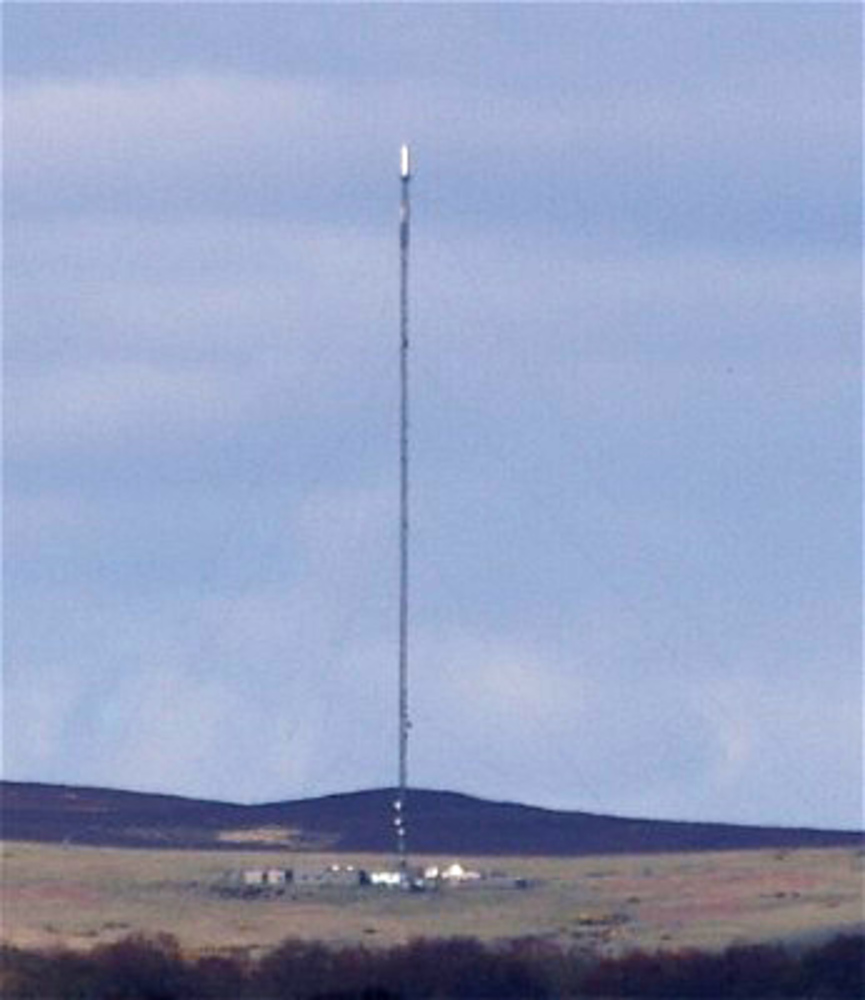 John - That's right, Richard. It's not so much in the instrument, it's more just a tube. We actually have a long tube which goes from the very top of the tower, about 220 metres up, and we sample air down this tube into some analysers which we have in a cabin just in front of us.
John - That's right, Richard. It's not so much in the instrument, it's more just a tube. We actually have a long tube which goes from the very top of the tower, about 220 metres up, and we sample air down this tube into some analysers which we have in a cabin just in front of us.
Richard - What are you trying to measure here?
John - I'm really trying to measure very accurately the greenhouse gas concentrations of the air as the air moves past the tower. So I'm interested in the concentration of the three big greenhouse gases: carbon dioxide, methane and nitrous oxide.
Richard - Okay, so you've got this tube, almost like a hose pipe, I suppose, coming down the tower, through this cabling duct and then behind us, through this door.
John - That's correct, yes. Let's go inside and see the instruments.
Richard - So you've got a stack of shelves with a computer on one, a mass of tiny little tubes on the other and occasionally, it's emitting a bit of a belching sound, and you're measuring greenhouse gases now?
John - We're trying to build up a picture of how the greenhouse gases change over time in this particular location. The reason we're on a tall tower - we take our samples from a tall tower - is that these samples that we observe at the tall tower actually reflect what's going on for many hundreds of kilometres upwind. On this particular day, we have a strong westerly wind. So the sample that we're measuring right now will have come probably from Ireland, several hours ago.
 Richard - Let's have a look outside because you're on this hill top. You can see the Tay bridge and Dundee. Over behind us is a transformer buzzing away. This heather - we look west. I mean, you can't see much beyond this hill, but the wind is coming that way and I suppose it's coming from Northern Ireland, the Irish Sea, Western Isles, Glasgow, and then a vast track of countryside, and it's hitting here, and that's what you're measuring.
Richard - Let's have a look outside because you're on this hill top. You can see the Tay bridge and Dundee. Over behind us is a transformer buzzing away. This heather - we look west. I mean, you can't see much beyond this hill, but the wind is coming that way and I suppose it's coming from Northern Ireland, the Irish Sea, Western Isles, Glasgow, and then a vast track of countryside, and it's hitting here, and that's what you're measuring.
John - Well that's right. We're probably sensing air that's coming from Ireland, possibly from the Atlantic. Indeed there are some days, you can actually measure the carbon monoxide that's come on forest fires in Canada. It can come that far and our instruments are that sensitive that we can actually sniff the air coming from different continents altogether.
Richard - And what are you finding? You're presumably seeing a natural process, and you're also seeing our contribution, the human contribution to greenhouse gases.
John - Well we are. Particularly, we're looking at methane and carbon monoxide to look at the anthropogenic influence. Carbon dioxide is a very interesting gas of course because it reflects what the natural vegetation is doing. So we see a trend in CO2 over the 5 years that we've been here, but we also see cycles in that trend as well, and that reflects what the biosphere is doing, what the oceans are doing, what the land surface is doing. Also sometimes, if you're looking at carbon monoxide or methane, you see spikes or sudden increases. They may all be because the air which is coming past our tower has actually gone perhaps Dundee or Glasgow or somewhere else then.
Richard - Can you give an example then of something you've seen that you could say, well that's a result of a particular activity?
John - Particularly on a calm clear night, perhaps you'd have a southerly wind at this site, and what we'd actually do is we would sniff Dundee, and we'd see that as a relatively high peak in our data. As the day went on, as more mixing came along, that would go away and we'd start to see the natural influence.
Richard - And that is the point really, isn't it? You're measuring what's happening now, but you're looking at the trends and seeing what is happening to the atmosphere over time.
John - I suppose what drives this science really is, where are the carbon sources and things? We really don't know where carbon goes once it leaves your tail pipe or your chimney. We know about half of it stays in the atmosphere and about half of it goes in the oceans, and the land. So it's a bit like a detective story. We can actually interrogate our data and figure out what the land surface or what the ocean is doing.
Dave - That was John Moncrieff from the University of Edinburgh talking to Richard Hollingham.
If you enjoyed that, there are more of Richard's podcasts as well as links to other Planet Earth resources here.
What is an aneurysm?
We put this question to Dr Suzy Lishman:
Suzy - Thanks for that question, Fred. I'm sorry to hear about your wife, my condolences. Well, an aneurysm, as you know, is a bulge in the blood vessel wall. It's a bit like a balloon that blows up and it becomes weak, and so it can burst. When that happens, blood leaves the blood vessel and goes out into the brain. The effect it has on the brain depends a little bit on exactly where the vessel is, in relation to the layers of the brain. If it bursts into the main matter of the brain itself, then it will destroy that brain tissue and that would present with somebody having a stroke for example. It could burst into the surroundings of the brain, the subdural space, and then it can cause an extremely bad headache because blood is very irritant and it can cause pain over the surface of the brain. But when somebody suffers a fatal aneurysm, as it sounds like your wife did, the blood destroys the brain so that it can no longer make the body function and breath, and somebody would stop breathing instantly because of the damage to the brain. So it's like a large stroke that kills bits of the brain that were essential for life.

How can humidity make us both hot and cold?
Dave - Quite a lot of this effect is down to the fact that, if the air is very humid, it's likely to also be drizzling: there's actually droplets of water in the air that will drop on your skin and then evaporate, and that makes you feel very, very cold.
Also, I think, water vapour will have a slightly higher specific heat capacity: it will be able to absorb slightly more energy per unit volume than normal air because it's a more complicated molecule, so it can vibrate in more exciting, different ways so it can absorb more energy as it warms up.
Whereas, when it's warm, if it's very, very high humidity, sweating doesn't work anymore because water doesn't evaporate very well and you feel very warm.
Chris - So, on a cold day, if you've got air which has got a bit of water in it and it's cold, you got to supply a lot of energy to that wet air to make it get any hotter. Therefore, it's always going to feel a bit colder, isn't it...
Dave - Yes.
Chris - Then, in summer, when the water is already saturating the air because of high humidity and you're trying to sweat to lose the energy, you can't lose the heat quick enough. So it's two slightly different things going on which is why you've actually got the difference?
Dave - Of course in this country as well, it tends to be windier when it's wet, just because of the way the weather works. So, you get wind chill added on top of that. I think windchill is probably a bigger [effect] when it's low humidity than the high humidity, but I think it [tends to be] windier when it's damp.
Why are some babies allergic to milk?
Chris - You shouldn't have a baby that's allergic to breast milk because breast milk has proteins in it that we make in our own body and therefore, it's very difficult to be allergic to things like that. Breast milk is a pretty special mixture.
You do get babies that won't breastfeed properly and so, parents then in frustration would turn to bottled feeds - because the baby needs the energy, and the baby is not growing fast enough so you put the baby on bottled feeds to try and get the baby growing a bit quicker. Then a baby can show an allergic reaction to what's in the bottled feed. That's because bottled milk does contain cow's milk proteins and as you know, the bulk of what we get in milk is things like calcium plus protein, and the body can recognise the cow's milk proteins as being foreign, and that's one reason.
Another thing that is in milk is lactose and humans have evolved, not necessarily to eat milk. And so, some people, especially people who are white and from our part of the world, actually may have a thing called lactose intolerance, and this is where they can't make an enzyme which is normally expressed in the intestine and breaks down lactose which is a sugar. It's two glucose molecules stuffed together. They lack an enzyme, lactase which will break those molecules apart. And so, the lactose carries on down the intestine and it pulls water into the intestine, causing bloating and diarrhoea-like symptoms and that's lactose intolerance. People who eat a lot of milk or dairy products, if they overdo it and they have that particular deficiency will get those symptoms. So that's another reason why a baby might be intolerant.
Some babies are just very allergic to things and some of the other things we're discussing earlier, with things like having lots of antibiotics or having a caesarean section can make some people more prone to develop more allergies as they go along.
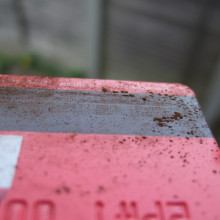
Magnetic Fingerprinting - Reading a Credit Card
What are 2D barcodes?
Dave - A normal bar code encodes information in black and white stripes, and there's a very limited amount of data you can store because you can't get very many black and white stripes without making your product about the size of the planet. So if you want to get more information on that, you can store the information, instead of in stripes, in spots. You can't read it with a conventional bar code reader anymore because it can't scan across it. It's got to take a picture of it and then decode the picture, but this can store - instead of maybe 30 or 40 characters of data, it can store up to 3,000. So you can actually store useful information about the product as well as just to identify it.

Do atoms break when we break something?
Dave - A very good question...
It depends what you mean by break up the atom. Actually, an atom is made up of a nucleus in the centre with all the electrons on the outside.
It's relatively easy to break electrons off the outside of an atom and sometimes when you break a material, you can rip off some of the electrons on one side and not the other.
This is the reason why, if you crush things like sugar, sometimes you build up more charge on one side than the other, and you get sparks going back again and so you'll get little flashes inside the sugar.
But the actual nuclei of the atoms don't break at all when you do anything like that. You need to do something far more violent to it, involving a nuclear reactor or radiation, something far bigger and more violent than that.

Where does phlegm come from?
We posed this question to Dr Suzy Lishman...
Suzy - There is a tube connecting the lungs to the mouth and that's called the trachea. It's the one you can feel - if you just feel the front of your throat just under the Adam's apple, that's the trachea.
That's lined by mucous membranes, the epithelial cells that produce mucus, which is a thick liquid that forms a phlegm. It has several functions; it's partly a lubricant, so it stops the airways from drying out when you breath dry air in and out, and it also helps get rid of bacteria and things that you really don't want to have down in your lungs.
They get stuck in this sticky mucus that lines the airways and then it can be coughed up, and it keep it away from the lungs.
What happens when you get a cold is, in reaction to the extra irritation of your airways, these epithelial cells produce more and more mucus. When you're fit and healthy, the mucus is normally clear and white, but if you get an infection, it can go yellow or even green, as you cough up all the bacteria and the dead cells that your lungs don't want.
Weight of red cells made in a lifetime?
The average adult makes 200 billion red blood cells every single day. It's about 2 Ã?,½ million every second, which is absolutely incredible. You've got about 20 to 30 trillion in your circulation and you have to replace that - about 1% of them - every single day. You kill 1% of them and you make another 1% of them. So, it should be fairly simple: you just take the number that get made every single day, you times it by how many days in a year - 365, you times that by 75 years in a lifetime, and then you times it by the weight of a red blood cell, and you get the answer. How much does a red blood cell weigh? Well I had to look for that and it turns out, the weight of a red blood cell can change across your lifetime. I found a paper by Mischlinzski and Koshak who are from Gdansk Medical School and they tell me that the weight of a red blood cell is, on average, about 45 picograms - 45 x 10-12 grams - per cell. So, if you times all those numbers together, you get 246,375 grams of red blood cells made in a lifetime, which is 246 kilograms or a quarter of a tonne, an absolutely staggering number, or weight, of red blood cells. Reference: Andrzej Mysliwskia and Anna Korczak, Mechanisms of Ageing and Development, Volume 34, Issue 2, April 1986, Pages 111-115
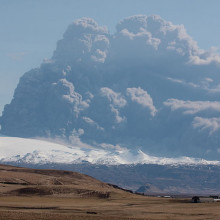
54:37 - Which are worse for the environment, volcanic eruptions or plane emissions?
Which are worse for the environment, volcanic eruptions or plane emissions?
We posed this question to Pablo Päster, a Greenhouse Gas Engineer and Columnist for treehugger.com...
Pablo - Informationisbeautiful.net actually did a great analysis of this and showed that the European aviation industry has about twice as many emissions as the volcano on a regular day. So the volcano has an estimated 150,000 metric tonnes of greenhouse gas emissions whereas the European aviation industry has 344,000 metric tons of greenhouse gas emissions. So, there's actually over 200,000 tonnes saved per day by cancelling 60% of the flights across Europe. Volcanic greenhouse gas emissions are quite different from human greenhouse gas emissions in that, they have been coming out at a steady state over time whereas we are now artificially changing that balance so that the rate of emissions versus the rate of absorption has been accelerated or put out of balance. The US Environmental Protection Agency estimates that the global greenhouse gas emissions from human activities totalled 28 trillion metric tonnes in 2006, so that's put this volcano in some perspective. In 2008, the greenhouse gas emissions of oil company Chevron and power company AEP, exceeded the greenhouse gas emissions from volcanoes in that year. Diana - Even an enormous volcanic eruption cannot match the European aviation industry for carbon emissions. It's thought that just over 200,000 tons of carbon dioxide per day where not emitted as a result of grounding 60% of the flights in and around Europe. With the volcano emitting 150,000 tonnes per day, it would mean that the volcano is better for the atmosphere by 50,000 tons of CO2 per day. On a few bad days, it's estimated that Eyjafjallajokul emitted up to 300,000 tonnes of CO2 which would make it worse to the tune of 100,000 tonnes than the flights which would've otherwise been in the air.










Comments
Add a comment